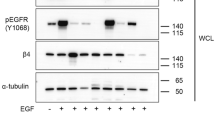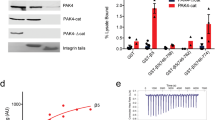Abstract
The integrin family of adhesion receptors are involved in cell growth, migration and tumour metastasis1. Integrins are heterodimeric proteins composed of an α and a β subunit, each with a large extracellular, a single transmembrane, and a short cytoplasmic domain. The dynamic regulation of integrin affinity for ligands in response to cellular signals is central to integrin function2. This process is energy dependent and is mediated through integrin cytoplasmic domains3. However, the cellular machinery regulating integrin affinity remains poorly understood. Here we describe a genetic strategy to disentangle integrin signalling pathways. Dominant suppression occurs when overexpression of isolated integrin β1 cytoplasmic domains blocks integrin activation. Proteins involved in integrin signalling were identified by their capacity to complement dominant suppression in an expression cloning scheme. CD98, an early T-cell activation antigen that associates with functional integrins4, was found to regulate integrin activation. Furthermore, antibody-mediated crosslinking of CD98 stimulated β1 integrin-dependent cell adhesion. These data indicate that CD98 is involved in regulating integrin affinity, and validate an unbiased genetic approach to analysing integrin signalling pathways.
This is a preview of subscription content, access via your institution
Access options
Subscribe to this journal
Receive 51 print issues and online access
$199.00 per year
only $3.90 per issue
Buy this article
- Purchase on Springer Link
- Instant access to full article PDF
Prices may be subject to local taxes which are calculated during checkout




Similar content being viewed by others
References
Hynes, R. O. Integrins: versatility, modulation and signaling in cell adhesion. Cell 69, 11–25 (1992).
Schwartz, M. A., Schaller, M. D. & Ginsberg, M. H. Integrins: emerging paradigms of signal transduction. Annu. Rev. Cell Biol. 11, 549–599 (1995).
Williams, M. J., Hughes, P. E., O'Toole, T. E. & Ginsberg, M. H. The inner world of cell adhesion: integrin cytoplasmic domains. Trends Cell Biol. 4, 109–112 (1994).
Mannion, B. A., Berditchevski, F., Eble, J. A. & Hemler, M. E. Functionally active β1integrins show specific association with CD98 protein.(submitted).
Baker, E. K. et al. Agenetic analysis of integrin function: Glanzmann thrombasthenia in vitro. Proc. Natl Acad. Sci. USA 94, 1973–1978 (1997).
O'Toole, T. E. et al. Integrin cytoplasmic domains mediate inside-out signal transduction. J. Cell Biol. 124, 1047–1059 (1994).
Chen, Y. et al. “Inside-Out” signal transduction inhibited by isolated integrin cytoplasmic domains. J. Biol. Chem. 269, 18307–18310 (1994).
LaFlamme, S. E., Thomas, L. A., Yamada, S. S. & Yamada, K. M. Single subunit chimeric integrins as mimics and inhibitors of endogenous integrin functions in receptor localization, cell spreading and migration, and matrix assembly. J. Cell Biol. 126, 1287–1298 (1994).
Hofmann, K. & Stoffel, W. F. Adatabase of membrane spanning protein segments. Hoppe-Seylers Z. Biol. Chem. 347, 166–180 (1993).
Altschul, S. F., Gish, W., Miller, W., Myers, E. W. & Lipman, D. J. Basic local alignment search tool. J. Mol. Biol. 215, 403–410 (1990).
Quackenbush, E. et al. Molecular cloning of complementary DNAs encoding the heavy chain of the human 4F2 cell surface antigen: a type II membrane glycoprotein involved in normal and neoplastic cell growth. Proc. Natl Acad. Sci. USA 84, 6526–6530 (1987).
Haynes, B. F. et al. Characterization of a monoclonal antibody (4F2) that binds to human monocytes and to a subset of activated lymphocytes. J. Immunol. 126, 1409–1414 (1981).
Berditchevski, F., Zutter, M. M. & Hemler, M. E. Characterization of novel complexes on the cell surface between integrins and proteins with 4 transmembrane domains (TM4 proteins). Mol. Biol. Cell 7, 193–207 (1996).
Lindberg, F. P., Gresham, H. D., Schwarz, E. & Brown, E. J. Molecular cloning of integrin-associated rotein: an immunoglobulin family member with multiple membrane spanning domains implicated in αvβ3-dependent ligand binding. J. Cell Biol. 123, 485–496 (1993).
Wei, Y. et al. Regulation of integrin function by the urokinase receptor. Science 273, 1551–1555 (1996).
Elices, M. J., Urry, L. A. & Hemler, M. E. Receptor functions for the integrin VLA-3: Fibronectin, collagen and laminin binding are differentially influenced by ARG-GLY-ASP peptide and by divalent cations. J. Cell Biol. 112, 169–181 (1991).
Brown, E., Hooper, L., Ho, T. & Gresham, H. Integrin-associated protein: a 50-kD plasma membrane antigen physically and functionally associated with integrins. J. Cell Biol. 111, 2785–2794 (1990).
Ohgimoto, S. et al. Molecular characterization of fusion regulatory protein-1 (FRP-1) that induces multinucleated giant cell formation of monocytes and HIV gp160-mediated cell fusion. FRP-1 and 4F2/CD98 are identical molecules. J. Immunol. 155, 3585–3592 (1995).
Ohta, H. et al. Molecular and biological characterization of fusion regulatory proteins (FRPs): anti-FRP mAbs induced HIV-mediated cell fusion via an integrin system. EMBO J. 13, 2044–2055 (1994).
Shimizu, Y., Van Seventer, G. A., Horgan, K. J. & Shaw, S. Regulated expression and binding of three VLA (β1) integrin receptors on T cells. Nature 345, 250–253 (1990).
Lukashev, M. E., Sheppard, D. & Pytela, R. Disruption of integrin function and induction of tyrosine phosphorylation by the autonomously expressed β1integrin cytoplasmic domain. J. Biol. Chem. 269, 18311–18314 (1994).
Indig, F. E., Diaz-Gonzalez, F. & Ginsberg, M. H. Analysis of the tetraspanin CD9-integrin αIIbβ3(GPIIb-IIIa) complex in platelet membranes and transfected cells. Biochem. J. 326(in the press).
Hirt, B. Selective extraction of polyoma DNA from infected mouse cell cultures. J. Mol. Biol. 26, 365–369 (1967).
Hirawasawa, M., Shijubo, N., Uede, T. Y. & Abe, S. Integrin expression and ability to adhere to extracellular matrix proteins and endothelial cells in human lung cancer lines. Br. J. Cancer 70, 466–473 (1994).
Hughes, P. et al. Suppression of integrin activation: A novel function of a Ras/Raf-initiated MAP kinase pathway. Cell 88, 521–530 (1997).
Acknowledgements
We thank L. Baker for generation of the αβPy cell line and for discussions; S. Shattil and M. Schwartz for suggestions, and reviews of the manuscript; and our colleagues for the reagents acknowledged in the text. This work was supported by grants from the NIH and Cor Therapeutics. T.S. is an MRC (UK) travelling fellow, and P.E.H. is a fellow of the Leukemia Society of America.
Author information
Authors and Affiliations
Corresponding author
Rights and permissions
About this article
Cite this article
Fenczik, C., Sethi, T., Ramos, J. et al. Complementation of dominant suppression implicates CD98 in integrin activation. Nature 390, 81–85 (1997). https://doi.org/10.1038/36349
Received:
Accepted:
Issue Date:
DOI: https://doi.org/10.1038/36349
This article is cited by
-
dMyc-dependent upregulation of CD98 amino acid transporters is required for Drosophila brain tumor growth
Cellular and Molecular Life Sciences (2023)
-
CD98hc has a pivotal role in maintaining the immuno-barrier integrity of basal layer cells in esophageal epithelium
Cancer Cell International (2022)
-
CD98hc (SLC3A2) sustains amino acid and nucleotide availability for cell cycle progression
Scientific Reports (2019)
-
Cell metabolism regulates integrin mechanosensing via an SLC3A2-dependent sphingolipid biosynthesis pathway
Nature Communications (2018)
-
The multifunctional solute carrier 3A2 (SLC3A2) confers a poor prognosis in the highly proliferative breast cancer subtypes
British Journal of Cancer (2018)
Comments
By submitting a comment you agree to abide by our Terms and Community Guidelines. If you find something abusive or that does not comply with our terms or guidelines please flag it as inappropriate.



